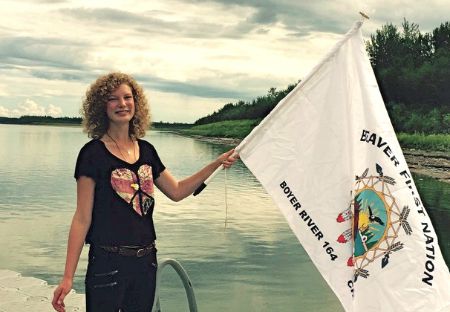
Mining engineering student Victoria Thomsen spent her summer co-op placement working with the Beaver First Nation, as part of an Engage North fellowship.
Mining engineering student Victoria Thomsen's most recent co-op placement with Engage North was rather unorthodox but, she says, it was "as real as it gets" in terms of developing communication and leadership skills, and learning to learn in new ways. Here is her story:
(Edmonton) I recently read an article from the New York Times by Lina Nilsson on How to attract female engineers that pinpointed my purpose as a University of Alberta student, which is to-quote: "focus on engineering that is cutting edge, with an explicit social context and mission."
I take great pride in my faculty and in my studies, and my story of being a woman mining engineering student is not just about challenging gender equality, but about taking responsibility for people's well-being, and doing better engineering to benefit us all. This mission led me to become involved with Engineers Without Borders three years ago, at the time when Engage North stemmed from EWB, but with a northern Canadian Indigenous contextualization of cultural understanding in its connection to technology.
The question "who is Henry?" will cross your mind; I assure you the answer will come if you read the following in full. This summer, I spent over three months living in Beaver First Nation (BFN) as an Engage North Fellow. BFN is part of Treaty 8 and approximately 200 km south of the 60th parallel, in what we know as Alberta. The First Nation's original ancestry was completely Beaver. Today members are mostly Beaver because members of different First Nations have married and become wholeheartedly accepted into the tribe over time. Also in today, severe impacts from residential schools persist. As Henry says, "former students treat one another the way they were taught and BFN lost a lot, the language, helping and sharing with one another and our culture which we are trying to get back today." Through this fellowship, I gained a sense of understanding, provided by the Beaver people themselves, about their background and unique culture. I had the chance to learn through them a different perspective about the functioning of institutions, governance, technology, and human interaction.
In working with in the Band Office, I was able to join the Chief, Council and the Band Manager in a series of meetings on land and resource advisory, including meetings with managers from the forest industry to negotiate ongoing terms of a working relationship, and Alberta Environment and Sustainable Resource Development to discuss the Nation's potential contribution and benefit towards the Land-Use Framework Regional Plans. As well, the band graciously invited me to attend a meeting for map review and site assessment protocols for three sites of a pipeline system expansion project. This led to a cumulative summer project in which I helped to create maps of the Nation's reserves, which will be an important tool for future resource discussions and development.
The Chief and Council and many of the band members are aware that I am going to school at the U of A for mining engineering, and some were quite shocked to see me come from an industrial background. However, through reciprocity in sharing and learning from one another's stories, we learned to understand each other's backgrounds. This in part facilitated the ability to work together, and to build a relationship of trust.
In volunteering to be a band chaperon for a provincial First Nations youth gathering in Maskwacis, I had the opportunity to provide a tobacco offering to an Elder in exchange for a Cree name. After telling him part of my story I was given the Cree name, Yospisimiskwew, for "gentle woman" in front of the some 200 attendees, in recognition of my connection to the community. I went and spoke to kokum (a grandmother) who told me that my name means someone who remains calm and collected in disruption or chaos.
A highly meaningful part of my trip was when Henry, an Elder, Council member, and previous Chief of Beaver First Nation welcomed me to come by his home for a visit. I was apprehensive to take on this offer, being unfamiliar with the customs, but found the courage to stop by. Henry and I ended up talking for six hours. He told me about the specific challenges the nation faces internally and externally. What has changed in comparison to the past and what he is concerned future generations will have to bear. Speaking with him solidified my observation that there are different ways of knowing, different ways of learning. I asked Henry how he did his studying and his research, his reply was by talking to many different Chiefs and elders from other Nations.
Three months living in Beaver is a relatively short period time, and an unorthodox co-op position for a mining engineering student, but the lessons I've learned are an invaluable complement to my technical skills. Looking at the long term, I was honoured to be a link through Engage North in building a relationship between Beaver First Nation and the University of Alberta, a little step towards learning from one another. Giving and receiving knowledge is a gift. I have been given a gift of the highest standard of teaching provided by the University of Alberta. I have been given a gift through Beaver First Nation and Engage North to learn in a different way. My future ambitions are to take these gifts to find common grounds between different groups of people so we may work together on what we cannot accomplish alone.